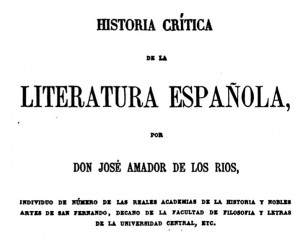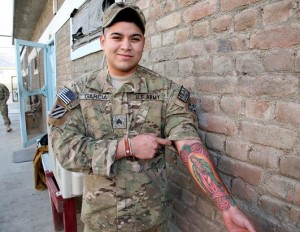The survey course of literature was originally designed to give students an introduction to the major authors, genres, and works of a given time period. It is a performance of literary history. The idea is for students to have a general familiarity with a national canon before they progress to the higher-level courses that specialize and go in depth into the study of a more specific time period, artistic movement, genre, author, or work.
This makes sense if you approach the study of literature as literary history. But the recent social science and cultural studies turn in literary studies has created different expectations and habits of thought among students and professors alike. Some are beginning to find the traditional survey course out of step with expectations and current practice.
In a recent discussion with some students in my survey course on Peninsular Spanish literature (1100-1600), I found that very few of them thought that a Spanish major was essentially (as I had always imagined it) an English major, but in Spanish. That is, they did not feel that the purpose of the Spanish major is to learn the literary history of Spain and Latin America, and to learn about the formal aspects and critical approaches to the literary critical study of poetry, fiction, drama, and film. In short, they didn’t care about literary history; they wanted to ‘learn Spanish.’ One stubborn student admitted that he liked to read books and write essays about them. But the rest saw it differently.
I am always tinkering with my survey course. I teach it at least twice a year, so I have lots of opportunities to swap readings out, fine-tune the written assignments, and update my lecture notes and activities. In light of this recent discussion with my students, I decided on a more radical overhaul this time around.
Many students in survey courses of Spanish and Latin American literature (in US universities) are language learners who are in their third or perhaps fourth year of study. They are not anywhere near as proficient in Spanish as the average English major is in English. It makes sense that the survey courses they take would not simply be a Spanish-language version of a survey of English literature. Many third-year language textbooks rubricate readings thematically, opening the unit with a general discussion of the theme (migration, women’s rights, pollution, family structure, etc) then progressing to a related reading with activities and written assignments designed to reinforce student’s understanding of the theme and their command of key vocabulary.
I adopted this approach in structuring my survey courses. I maintain a chronological structure that begins in the eleventh century and ends in the seventeenth. The main difference is in the presentation of the texts. The syllabus introduces each reading with a ‘big question,’ designed to point up the broader social, religious, or political significance of the text. In formulating the questions, I asked myself “what is interesting about this text?” (Not “how have literary historians explained the significance of this text” or “why is this text important for the development of Spanish literature?”).
For example, the unit on Marian miracles (we read one of the miracles in Gonzalo de Berceo’s Milagros de Nuestra Señora) asks “Why do we want God to be a woman?” For many of the readings, there is an excerpt of a contemporary essay on a related topic, and an additional primary text from the period on the same subject, and the occasional excerpt of a secondary literary critical essay.
The Question-driven syllabus
The ‘big question’ for each reading sets the agenda for the class meetings, discussion section meetings, and written assignments. For each syllabus entry, there is a question, key terminology or themes, a debate topic, and a creative assignment (práctica). In a given lecture meeting you might begin with an individual writing exercise and/or small group discussion of the question, then segue into coverage of the excerpt of a modern essay on a related topic (for the Catholic Monarchs’ Edict of Expulsion we’ll read an excerpt from an essay on ethnic cleansing) or a related primary text from the same period. Discussion section leaders can choose to assign students to prepare both sides of the debate based on textual evidence from primary and/or secondary texts. Alternatively they can choose to have students prepare the creative assignment, which can in turn form the textual basis for activities conducted during section.
 Click here to see the full syllabus
Click here to see the full syllabus
None of these adjustments in approaching classic texts means that literary history is consigned to the dustbin. They still learn about Gonzalo de Berceo’s biography, about the emergence of Castilian as a literary language, about Catholic Mariology and popular Marian practices. It is still a survey course of (mostly) canonical texts; one geared for students who do not necessarily see themselves first and foremost as lit majors.
There will be skeptics. They will accuse me of pandering to students’ obsession with ‘relatability,’ of giving in to the tyranny of present-ism. But I think leading with the question is simply good humanism. It helps remind us of how these texts we love to read and teach speak to the human condition. And if our students, even our Spanish majors, are not necessarily presold on the humanities, I don’t see any harm in reminding them why they should be.




David, I’m on the road and can’t compose the sort of response your essay deserves. I do agree with you and am delighted that you’re addressing this issue. My cultural studies (i.e., Latin American) colleagues banished literary surveys a decade ago and I have not been allowed to teach one. Since there are no surveys of any kind, the curriculum has collapsed into radical presentism and most our majors graduate without ever leaving the last 30 years, that is the dissatisfactions and resentments of their teachers’ adult memories. Our program has traded curriculum for social causes and the past itself has become the enemy, the place where today’s evils come from. Cervantes has not been available in any form for over 12 years but neither has Lorca, Galdós, Borges, Lope, Lazarillo, Bécquer, Cortázar, Calderón, Martí, etc. All authors are skippable and all authors skipped in favor of the plight of one group or another. It’s pretty discouraging. One of the purposes of the survey is mapping a culture and its artifacts and there are lots of interesting ways to do it, including temporal mapping, and I fear that with no map at all we’re disqualifying students from continuing in this field, fulfilling the charge that what we do on the undergraduate level is a dead end. The course you teach on Spanish literature from 1100-1600 shows the lumping of the past into great spans of time that apparently deserve no more attention than 3 credits in one semester. Will we soon teach a single course on 1100-1900?
George, thanks very much for your comment. A colleague today emailed and said that she was (actually) teaching a survey on 1100-1900… DAW
I like what you are doing, in principle if not always in the specifics. I preceded you as a grad student at Berkeley by some 40 years, and I can assure you there is nothing new in hearing undergraduates wonder aloud why the major in Spanish entails so much study of literature. As you know, many departments have recast the major, some (such as William and Mary) going quite far in the direction of an issues-based curriculum. I hope George Greenia weighs in here.
Even in a fairly traditional literature major, I think you are correct to question the value of the survey course for undergraduates, even advanced ones. Surveys didn’t do what they were supposed to when I first started teaching them in the early 60’s, and I can only imagine how it is now. There is plenty of time for that on the graduate level, where they make more sense.
I am happy to see discussion on this point, as examination and reaffirmation of what we are and have been doing over the years merits attention. As an academic and educator for the past 40 years I have always known that the key to teaching the “old, difficult” literature of Spain lies in our ability to make it relavent to the modern world. If one is passionate about the subject, the enthusiasm and love for the masterpieces will be transferred. I have had secondary Pre-AP and AP students over the years excited about El Cid, Lazarillo and Cervantes. They have read pertinent excerpts in the original language and have come to enjoy the humor, life lessons and historical significance of each. I believe it is all in the “packaging,” not unlike everything else in this world.
On reflection of my years as a student, one of the things I believe I missed was an understanding of just how little is new in the human story. Like most students, I was too quick to dismiss learning about things which didn’t seem to fit into my notion of what I needed to know now. So, I hope those of you in the academic world will keep working to make sure that the lessons of history are not sacrificed totally to the urge to be proficient in a language.
David, I think your approach has a lot of merit. At the my Cal State institution, where we teach fairly traditional survey courses, most of our Spanish majors are native or heritage speakers. Nevertheless, in the survey courses I teach — mainly Hispanic America 1492-Independence — I’ve adopted a similar approach to yours (though I haven’t overhauled the curriculum to the same degree). I believe by its nature literature opens us to the “big questions,” so why ignore it? As an undergraduate the lit classes that were most engaging were those where the prof. was able to tap into that. I’ve found that my own classes have become more interesting, for both the students and me. And like you, I teach mostly canonical texts and integrated a good deal of historical and literary context.